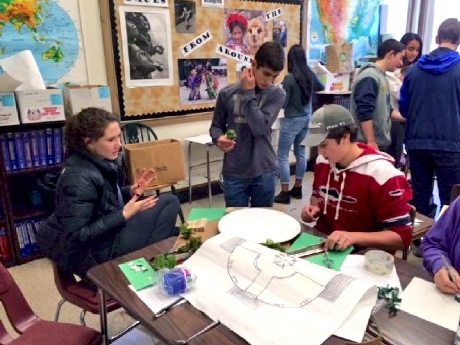How might we encourage our students to become global leaders?
How might we create agency, or a mindset of action, in 21st century kids?
Our students are passive. They are used to “sitting and getting” information. Even as we talk about preparing students for the 21st century, the pressures of college acceptance and testing make it difficult to change students’ (and parents’) mindsets. How might we create a bias towards action in our students so that they understand their own power and ability to change their world? The answer is simple: start small, make it relevant and local, and use Design Thinking to manage the process.
I see it everyday in my own classroom. Ask students to get up and move and they groan, ‘Do we have to?’ or ‘I’m so tired.’ And in truth, most of them are exhausted by jumping through the seemingly endless hoops required of them for acceptance to “that” college. Creating a generation of ‘doers’ is possible if you start small and get them hooked by changing something local.
Look around you for inspiration.
What do students complain about? What affects their lives? Starting small, scaffolding skills and building creative confidence is imperative. It would be paralyzing for a 14 year old to be asked to solve a real world problem right off the bat, but by starting ‘local’ and using Design Thinking as a process, anything is possible.

Start Here
Start with a simple design challenge that anyone can do. Redesign the gift giving experience is an easy one that students can relate to. Experiencing the design cycle is the only way to learn it. The outcome can be anything, but the important thing is that students truly follow the process without jumping to solutions. Using Design Thinking allows students to become comfortable with the “not-knowing” and iterative parts of the creative process.
Find a Local Challenge
Once students have practiced, look for a local challenge. My students have proposed new design solutions for our school library, cafeteria, as well as our local public library’s young adult and children’s rooms, and made furniture for our Learning Commons. Ask your students to be on the lookout for “bad” design or opportunities for improvement. This helps shift students’ mindset from consumers to a bias towards action.
Dig Deeper
Once you have identified a local challenge, dive into the design process. The first step: research and empathy. This can be difficult for students who are used to finding the “right” answer fairly quickly. Ask them to hold off looking for solutions while they explore others’ perspectives and all aspects of the problem. I create a design ‘parking lot’ where students can put solutions they’ve thought of, this way it’s easier to let go of them and embrace the process. With each challenge, we map the stakeholders and then require students to interview someone from each group.
What skill do global citizens need more than empathy? And what better way to learn it than by unpacking a complex problem and looking at it from different perspectives? Empathy needs to be part of our children’s decision-making process and Design Thinking is an effective way to teach it.
As children struggle with real life problems, even ones that are in their own schools and communities, they learn to put themselves in others’ shoes and consider the issue from other vantage points. Following the design process allows students to consider multiple solutions as they brainstorm. They gain insight from making rough prototypes, testing them and reiterating based on feedback. And when, finally, they propose solutions and real people listen, they learn that their ideas and solutions are valued. They begin to see the world as a place where they can affect change.
We need to foster a mindset of action and nurture students who are ready and equipped to take on the tough, complex problems of the world. So even though students begin by solving small, local problems, they develop a mindset of doing. Design Thinking gives them a process and allows them to practice vitally important skills for life.
Here are further ideas and resources for global scale Design Thinking projects:
- Extreme By Design: An interactive experience designed for 4th through 12th grade students, to be completed after watching the Extreme By Design documentary. Learning Episode 1 (“Being an Innovator”) will help students think and act like innovators using the design thinking approach.
- “A Design Challenge to Students: Solve a Real-World Problem!” Blog Article: Provides a couple of design challenge ideas to use with elementary and high school students.
- The Ethics Institute at Kent Place School: This innovative program will bring teams of educators and students from schools across the metro-New York area to the Kent Place School campus to develop new approaches and solutions to complex real-world issues within their respective school communities using methods adapted from the Ethical Decision-Making Model and Design Thinking.
- “Empathy on the Edge”: An essay on exploring how design empathy thinking works.
- “Design Thinking, Making, and Learning from the Heart”: A blog highlighting the process of design thinking to redesign high school social studies curriculum.
For breakfast I had an English Breakfast Tea in a big mug with milk and sugar, a few slices of cheese, and an apple.
Author Profile: @lisayokana
Image credit: Lisa Yokana, Emily Block, and Fallon Plunkett
